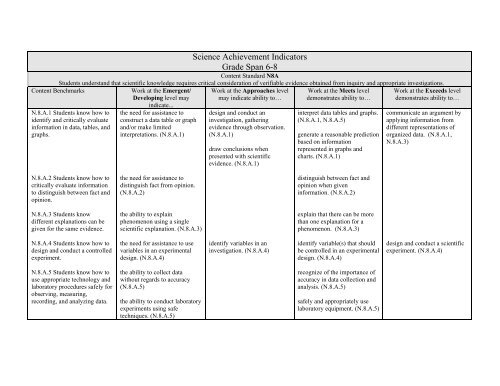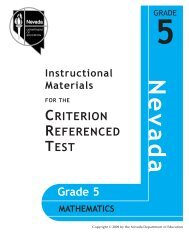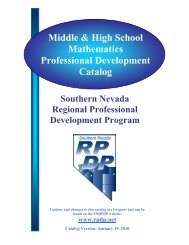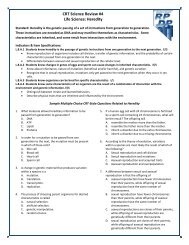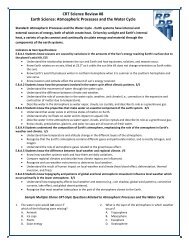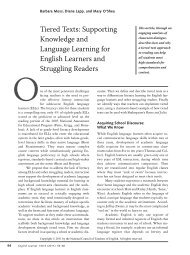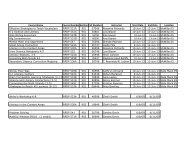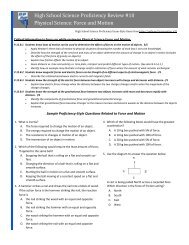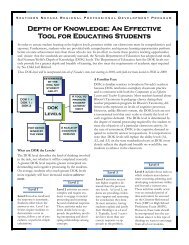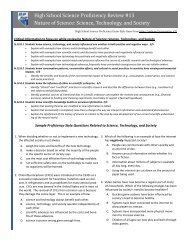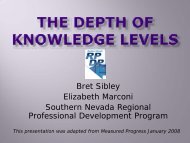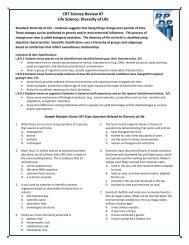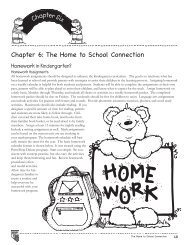Science Achievement Indicators Grade 6-8 - RPDP
Science Achievement Indicators Grade 6-8 - RPDP
Science Achievement Indicators Grade 6-8 - RPDP
You also want an ePaper? Increase the reach of your titles
YUMPU automatically turns print PDFs into web optimized ePapers that Google loves.
<strong>Science</strong> <strong>Achievement</strong> <strong>Indicators</strong><br />
<strong>Grade</strong> Span 6-8<br />
Content Standard N8A<br />
Students understand that scientific knowledge requires critical consideration of verifiable evidence obtained from inquiry and appropriate investigations.<br />
Content Benchmarks<br />
Work at the Emergent/<br />
Developing level may<br />
indicate...<br />
Work at the Approaches level<br />
may indicate ability to…<br />
Work at the Meets level<br />
demonstrates ability to…<br />
N.8.A.1 Students know how to<br />
identify and critically evaluate<br />
information in data, tables, and<br />
graphs.<br />
the need for assistance to<br />
construct a data table or graph<br />
and/or make limited<br />
interpretations. (N.8.A.1)<br />
design and conduct an<br />
investigation, gathering<br />
evidence through observation.<br />
(N.8.A.1)<br />
draw conclusions when<br />
presented with scientific<br />
evidence. (N.8.A.1)<br />
interpret data tables and graphs.<br />
(N.8.A.1, N.8.A.5)<br />
generate a reasonable prediction<br />
based on information<br />
represented in graphs and<br />
charts. (N.8.A.1)<br />
Work at the Exceeds level<br />
demonstrates ability to…<br />
communicate an argument by<br />
applying information from<br />
different representations of<br />
organized data. (N.8.A.1,<br />
N.8.A.3)<br />
N.8.A.2 Students know how to<br />
critically evaluate information<br />
to distinguish between fact and<br />
opinion.<br />
the need for assistance to<br />
distinguish fact from opinion.<br />
(N.8.A.2)<br />
distinguish between fact and<br />
opinion when given<br />
information. (N.8.A.2)<br />
N.8.A.3 Students know<br />
different explanations can be<br />
given for the same evidence.<br />
the ability to explain<br />
phenomenon using a single<br />
scientific explanation. (N.8.A.3)<br />
explain that there can be more<br />
than one explanation for a<br />
phenomenon. (N.8.A.3)<br />
N.8.A.4 Students know how to<br />
design and conduct a controlled<br />
experiment.<br />
the need for assistance to use<br />
variables in an experimental<br />
design. (N.8.A.4)<br />
identify variables in an<br />
investigation. (N.8.A.4)<br />
identify variable(s) that should<br />
be controlled in an experimental<br />
design. (N.8.A.4)<br />
design and conduct a scientific<br />
experiment. (N.8.A.4)<br />
N.8.A.5 Students know how to<br />
use appropriate technology and<br />
laboratory procedures safely for<br />
observing, measuring,<br />
recording, and analyzing data.<br />
the ability to collect data<br />
without regards to accuracy<br />
(N.8.A.5)<br />
the ability to conduct laboratory<br />
experiments using safe<br />
techniques. (N.8.A.5)<br />
recognize of the importance of<br />
accuracy in data collection and<br />
analysis. (N.8.A.5)<br />
safely and appropriately use<br />
laboratory equipment. (N.8.A.5)
<strong>Achievement</strong> <strong>Indicators</strong> for <strong>Science</strong><br />
<strong>Grade</strong>s 6-8<br />
Content Standard N8A (continued)<br />
Students understand that scientific knowledge requires critical consideration of verifiable evidence obtained from inquiry and appropriate investigations.<br />
Content Benchmarks<br />
Work at the Emergent/<br />
Developing level may<br />
indicate...<br />
Work at the Approaches level<br />
may indicate ability to…<br />
Work at the Meets level<br />
demonstrates ability to…<br />
N.8.A.6 Students know<br />
scientific inquiry includes<br />
evaluating results of scientific<br />
investigations, experiments,<br />
observations, theoretical and<br />
mathematical models, and<br />
explanations proposed by other<br />
scientists.<br />
N.8.A.7 Students know there<br />
are multiple methods for<br />
organizing items and<br />
information.<br />
the need for assistance to<br />
identify a theoretical model to<br />
explain a scientific<br />
phenomenon. (N.8.A.6)<br />
develop theoretical models to<br />
explain scientific phenomenon.<br />
(N.8.A.6)<br />
evaluate results from a<br />
scientific investigations,<br />
experiments, and observations.<br />
(N.8.A.6)<br />
Work at the Exceeds level<br />
demonstrates ability to…<br />
evaluate data for precision and<br />
accuracy based upon repeated<br />
experimentation shared through<br />
individual and collaborative<br />
work. (N.8.A.4, N.8.A.6)<br />
demonstrate cause-effect<br />
relationships using models.<br />
(N.8.A.6)<br />
August 2007 2
<strong>Achievement</strong> <strong>Indicators</strong> for <strong>Science</strong><br />
<strong>Grade</strong>s 6-8<br />
Content Benchmarks<br />
N.8.B.1 Students understand<br />
that consequences of<br />
technologies can cause resource<br />
depletion and environmental<br />
degradation, but<br />
technology can also increase<br />
resource availability, mitigate<br />
environmental degradation, and<br />
make new resources<br />
economical.<br />
Content Standard N8B<br />
Students understand the interactions of science and society in an ever-changing world.<br />
Work at the Emergent/ Work at the Approaches level Work at the Meets level<br />
Developing level may may indicate ability to… demonstrates ability to…<br />
indicate...<br />
recognition that the world is<br />
constantly changing. (N.8.B.1)<br />
recognition that technologies<br />
and resources are related.<br />
(N.8.B.1)<br />
recognize that changes have<br />
costs or benefits associated with<br />
them. (N.8.B.1)<br />
give examples of the effect of<br />
technologies on resources.<br />
(N.8.B.1)<br />
explain that scientific<br />
contributions are made by<br />
individuals of all cultures,<br />
genders, ethnicities. (N.8.B.1)<br />
identify how the impact on<br />
society may be positive or<br />
negative when given an<br />
advance in technology.<br />
(N.8.B.1)<br />
recognize that there are costs<br />
and benefits associated with<br />
technology. (N.8.B.1)<br />
identify examples of the effect<br />
of technologies on resources.<br />
(N.8.B.1)<br />
Work at the Exceeds level<br />
demonstrates ability to…<br />
critique the costs/benefit<br />
tradeoffs of scientific,<br />
technological, and societal<br />
issues. (N.8.B.1)<br />
analyze the ethical influences<br />
on scientific, technological, and<br />
societal issues. (N.8.B.1)<br />
N.8.B.2 Students know<br />
scientific knowledge is revised<br />
through a process of<br />
incorporating new evidence<br />
gained through on-going<br />
investigation and collaborative<br />
discussion.<br />
recognition scientific<br />
knowledge has changed.<br />
(N.8.B.2)<br />
recognition that everybody can<br />
be a scientist. (N.8.B.2)<br />
ability to explain that scientists<br />
work together and share what<br />
they find out. (N.8.B.2)<br />
recognize that scientific<br />
knowledge is constantly<br />
changing as scientists<br />
investigate phenomena.<br />
(N.8.B.2)<br />
identify benefits of working<br />
with a team and sharing<br />
findings. (N.8.B.2)<br />
recognize that scientific<br />
knowledge is constantly<br />
changing as scientists<br />
investigate and share new<br />
information. (N.8.B.2)<br />
August 2007 3
<strong>Achievement</strong> <strong>Indicators</strong> for <strong>Science</strong><br />
<strong>Grade</strong>s 6-8<br />
Content Benchmarks<br />
P.8.A.1 Students know particles<br />
are arranged differently in<br />
solids, liquids, and gases of the<br />
same substance.<br />
Content Standard P8A<br />
Students understand the properties and changes of properties in matter.<br />
Work at the Approaches level<br />
may indicate ability to…<br />
Work at the Emergent/<br />
Developing level may<br />
indicate...<br />
recognition that matter can exist<br />
as solids, liquids, and gases and<br />
each are different. (P.8.A.1)<br />
recognize that matter can exist<br />
as a solids liquids, and gases<br />
with distinct physical<br />
properties. (P.8.A.1)<br />
Work at the Meets level<br />
demonstrates ability to…<br />
diagram the arrangement of<br />
particles in solids, liquids, and<br />
gases. (P.8.A.1)<br />
Work at the Exceeds level<br />
demonstrates ability to…<br />
differentiate molecular motion<br />
of particles in solids, liquids,<br />
and gases. (P.8.A.1)<br />
P.8.A.2 Students know<br />
elements can be arranged in the<br />
periodic table which shows<br />
repeating patterns that group<br />
elements with similar<br />
properties.<br />
recognize that elements are<br />
listed on a periodic table.<br />
(P.8.A.2)<br />
recognize that matter is made of<br />
small particles. (P.8.A.2)<br />
explain that elements are<br />
represented by symbols in the<br />
periodic table. (P.8.A.2)<br />
predict the properties of<br />
different elements by their<br />
arrangements in groups and<br />
periods on the periodic table.<br />
(P.8.A.2)<br />
identify atoms and ions by<br />
calculating the number of<br />
neutrons, protons, and electrons<br />
(P.8.A.2)<br />
P.8.A.3 Students know methods<br />
for separating mixtures based<br />
on the properties of the<br />
components.<br />
recognize that many things are<br />
mixtures. (P.8.A.3)<br />
explain that when two materials<br />
are combined, they sometimes<br />
form a completely different<br />
material. (P.8.A.3)<br />
physically separate mixtures<br />
using the properties of matter.<br />
(P.8.A.3)<br />
experimentally apply the<br />
principles of magnetism,<br />
density, conductivity and<br />
solubility to separate mixtures.<br />
(P.8.A.3)<br />
the need of assistance to<br />
separate simple mixtures using<br />
filters, magnets and<br />
evaporation. (P.8.A.3)<br />
identify the following properties<br />
of matter: magnetism, density,<br />
conductivity and solubility.<br />
(P.8.A.3)<br />
distinguish between intrinsic<br />
and extrinsic properties.<br />
(P.8.A.3)<br />
ability to sort objects according<br />
to properties (i.e., color, size,<br />
weight, shape, texture)<br />
(P.8.A.3)<br />
August 2007 4
<strong>Achievement</strong> <strong>Indicators</strong> for <strong>Science</strong><br />
<strong>Grade</strong>s 6-8<br />
Content Benchmarks<br />
P.8.A.4 Students know atoms<br />
often combine to form<br />
molecules, and that compounds<br />
form when two or more<br />
different kinds of atoms<br />
chemically bond.<br />
Content Standard P8A (continued)<br />
Students understand the properties and changes of properties in matter.<br />
Work at the Approaches level<br />
may indicate ability to…<br />
Work at the Emergent/<br />
Developing level may<br />
indicate...<br />
ability to recognize that<br />
compounds are made of<br />
different atoms. (P.8.A.4)<br />
name the atoms in the following<br />
compounds: table salt, water,<br />
and carbon dioxide. (P.8.A.4)<br />
Work at the Meets level<br />
demonstrates ability to…<br />
construct models of molecules<br />
and compounds. (P.8.A.4)<br />
Work at the Exceeds level<br />
demonstrates ability to…<br />
describe how atoms combine to<br />
form molecules, based on their<br />
electrons. (P.8.A.4)<br />
P.8.A.5 Students know mass is<br />
conserved in physical and<br />
chemical changes.<br />
ability to recognize the phases<br />
of water as its temperature<br />
changes. (P.8.A.5)<br />
recognize that water’s phase of<br />
matter is related to its<br />
temperature. (P.8.A.5)<br />
illustrate that when matter goes<br />
through a physical or chemical<br />
change, the total mass remains<br />
the same. (P.8.A.5)<br />
construct simple chemical<br />
equations. (P.8.A.5)<br />
recognizes that the mass of a<br />
substance remains the same<br />
while undergoing physical<br />
change in a concrete example.<br />
(P.8.A.5)<br />
recognize that when matter goes<br />
through a physical change, the<br />
total mass remains the same.<br />
(P.8.A.5)<br />
recognize that the mass of a<br />
substance remains the same<br />
while undergoing chemical<br />
change in a concrete example.<br />
(P.8.A.5)<br />
distinguish between physical<br />
and chemical changes. (P.8.A.5)<br />
balance basic chemical<br />
equations. (P.8.A.5)<br />
P.8.A.6 Students know matter is<br />
made up of tiny particles called<br />
atoms.<br />
the ability to recognize that<br />
many objects are made of many<br />
different types of materials.<br />
(P.8.A.6)<br />
explain that an atom is<br />
“smaller” than a molecule.<br />
(P.8.A.6)<br />
name the atoms in a molecular<br />
formula for water, oxygen, and<br />
carbon dioxide. (P.8.A.6)<br />
recognize that all matter is<br />
made of tiny particles called<br />
atoms. (P.8.A.6)<br />
August 2007 5
<strong>Achievement</strong> <strong>Indicators</strong> for <strong>Science</strong><br />
<strong>Grade</strong>s 6-8<br />
Content Benchmark<br />
P.8.A.7 Students know the<br />
characteristics of electrons,<br />
protons, and neutrons.<br />
Content Standard P8A (continued)<br />
Students understand the properties and changes of properties in matter.<br />
Work at the Approaches level<br />
may indicate ability to…<br />
Work at the Emergent/<br />
Developing level may<br />
indicate...<br />
understands that there are<br />
different parts to the atom.<br />
(P.8.A.7)<br />
name the parts of an atom i.e.<br />
electron, protons, and neutrons.<br />
(P.8.A.7)<br />
Work at the Meets level<br />
demonstrates ability to…<br />
explain the location, charge,<br />
and relative mass of the<br />
electrons, protons, and<br />
neutrons. (P.8.A.7)<br />
Work at the Exceeds level<br />
demonstrates ability to…<br />
describe the relationships<br />
between protons, neutrons, and<br />
electrons in an atom. (P.8.A.7,<br />
P.8.A.6)<br />
P.8.A.8 Students know<br />
substances containing only one<br />
kind of atom are elements<br />
which cannot be broken into<br />
smaller pieces by normal<br />
laboratory processes.<br />
explain that elements contain<br />
only one type of atom.<br />
(P.8.A.8)<br />
August 2007 6
<strong>Achievement</strong> <strong>Indicators</strong> for <strong>Science</strong><br />
<strong>Grade</strong>s 6-8<br />
Content Benchmark<br />
P.8.B.1 Students know the<br />
effects of balanced and<br />
unbalanced forces on an<br />
object's motion.<br />
Content Standard P8B<br />
Students understand that position and motion of an object result from the net effect of the different forces acting on it.<br />
Work at the Emergent/ Work at the Approaches level Work at the Meets level<br />
Developing level may may indicate ability to… demonstrates ability to…<br />
indicate...<br />
ability to predict how an<br />
object’s position and /or motion<br />
will be changed when a push or<br />
pull is applied. (P.8.B.1)<br />
identify that unbalanced forces<br />
cause changes in an object’s<br />
motion. (P.8.B.1)<br />
apply the principles of balanced<br />
and unbalanced forces to<br />
describe the motion of an<br />
object. (P.8.B.1)<br />
Work at the Exceeds level<br />
demonstrates ability to…<br />
quantify the balanced and<br />
unbalanced forces to describe<br />
the speed and acceleration of an<br />
object. (P.8.B.1)<br />
ability to describe the speed of<br />
an object. (P.8.B.1)<br />
demonstrate that changes in an<br />
object’s motion are dependent<br />
on its mass and the strength of<br />
the unbalanced force applied.<br />
(P.8.B.1)<br />
recognition that a force is used<br />
to speed up or slow down an<br />
object. (P.8.B.1)<br />
P.8.B.2 Students know electric<br />
currents can produce magnetic<br />
forces and magnets can cause<br />
electric currents.<br />
ability to use magnets and/or<br />
electrically charged materials to<br />
move some objects without<br />
touching them. (P.8.B.2)<br />
identify materials and objects<br />
that can be attracted by<br />
magnetic forces. (P.8.B.2)<br />
predict what will happen when<br />
two electrically charged<br />
materials are moved together.<br />
(P.8.B.2)<br />
describe the relationship<br />
between electric current and<br />
magnetic forces. (P.8.B.2)<br />
demonstrate that an electric<br />
current can be used to produce a<br />
magnet. (P.8.B.2)<br />
August 2007 7
<strong>Achievement</strong> <strong>Indicators</strong> for <strong>Science</strong><br />
<strong>Grade</strong>s 6-8<br />
Content Benchmark<br />
P.8.B.3 Students know every<br />
object exerts gravitational force<br />
on every other object, and the<br />
magnitude of this force depends<br />
on the mass of the objects and<br />
their distance from one another.<br />
Content Standard P8B (continued)<br />
Students understand that position and motion of an object result from the net effect of the different forces acting on it.<br />
Work at the Emergent/ Work at the Approaches level Work at the Meets level<br />
Developing level may may indicate ability to… demonstrates ability to…<br />
indicate...<br />
ability to name gravity as a<br />
force. (P.8.B.3)<br />
ability to explain that gravity<br />
causes objects to fall to the<br />
ground unless something holds<br />
them up. (P.8.B.3)<br />
explain that gravity is the force<br />
that pulls any object toward<br />
Earth without touching that<br />
object. (P.8.B.3)<br />
recognize that gravitational<br />
force is related to “size” and/or<br />
distance of two objects.<br />
(P.8.B.3)<br />
explain that gravitational force<br />
depends on the relationship<br />
between object masses and the<br />
distances between them.<br />
(P.8.B.3)<br />
Work at the Exceeds level<br />
demonstrates ability to…<br />
describe gravity using the<br />
relationships between mass, and<br />
volume. (P.8.B.3)<br />
August 2007 8
<strong>Achievement</strong> <strong>Indicators</strong> for <strong>Science</strong><br />
<strong>Grade</strong>s 6-8<br />
Content Standard<br />
P.8.C.1 Students know visible<br />
light is a narrow band within<br />
the electromagnetic spectrum.<br />
Work at the Emergent/<br />
Developing level may<br />
indicate...<br />
ability to recognize a wave. e.g.<br />
a rope, ocean wave, sound,<br />
earthquake and “slinky.”<br />
(P.8.C.1, P.8.C.2)<br />
Content Standard P8C<br />
Students understand transfer of energy.<br />
Work at the Approaches level<br />
may indicate ability to…<br />
recognize that light and sound<br />
have wave properties. (P.8.C.1)<br />
recognize simple properties of<br />
light e.g. color, light and<br />
reflection. (P.8.C.1)<br />
Work at the Meets level<br />
demonstrates ability to…<br />
explain that there are visible<br />
and invisible wavelengths of<br />
light in the electromagnetic<br />
spectrum. (P.8.C.1)<br />
Work at the Exceeds level<br />
demonstrates ability to…<br />
P.8.C.2 Students know<br />
vibrations (e.g., sounds,<br />
earthquakes) move at different<br />
speeds in different materials,<br />
have different wavelengths, and<br />
set up wave-like disturbances<br />
that spread away from the<br />
source uniformly.<br />
ability to draw a wave and label<br />
parts with assistance. (P.8.C.2)<br />
identify the characteristics of a<br />
wave: wavelength, frequency,<br />
amplitude and speed. (P.8.C.2)<br />
recognize that waves are related<br />
to energy. (P.8.C.2)<br />
distinguish between an open<br />
and a closed circuit.<br />
Ability to describe kinetic<br />
energy. (P.8.C.6)<br />
describe the characteristics of a<br />
wave: wavelength, frequency,<br />
amplitude and speed. (P.8.C.2)<br />
describe that waves transfer<br />
energy differently (e.g. sound,<br />
earthquake and light), in<br />
different materials i.e. solids,<br />
liquids and gases. (P.8.C.2)<br />
use models to demonstrate the<br />
transfer of energy in waves.<br />
(P.8.C.2)<br />
demonstrate that waves transfer<br />
energy differently in different<br />
materials. (P.8.C.2)<br />
describe that waves travels<br />
through solids, liquids, and<br />
gases. (P.8.C.2)<br />
P.8.C.3 Students know physical,<br />
chemical, and nuclear changes<br />
involve a transfer of energy.<br />
recognition that energy is<br />
present in objects. (P.8.C.3,<br />
P.8.C.4)<br />
describe kinetic energy.<br />
(P.8.C.3, P.8.C.4)<br />
differentiate between kinetic<br />
and potential energy. (P.8.C.3)<br />
explain that in physical,<br />
chemical, and nuclear changes<br />
energy is transformed. (P.8.C.3)<br />
August 2007 9
<strong>Achievement</strong> <strong>Indicators</strong> for <strong>Science</strong><br />
<strong>Grade</strong>s 6-8<br />
Content Standard<br />
P.8.C.4 Students know energy<br />
cannot be created or destroyed,<br />
in a chemical or physical<br />
reaction, but only changed from<br />
one form to another.<br />
Work at the Emergent/<br />
Developing level may<br />
indicate...<br />
Content Standard P8C (continued)<br />
Students understand transfer of energy.<br />
Work at the Approaches level<br />
may indicate ability to…<br />
name different types of energy.<br />
(P.8.C.4)<br />
Work at the Meets level<br />
demonstrates ability to…<br />
explain that one form of energy<br />
can be changed into another<br />
form of energy. (P.8.C.4)<br />
Work at the Exceeds level<br />
demonstrates ability to…<br />
P.8.C.5 Students know heat<br />
energy flows from warmer<br />
materials or regions to cooler<br />
ones through conduction,<br />
convection, and radiation.<br />
recognition that hot objects<br />
cool, and cool objects warm.<br />
(P.8.C 5)<br />
identify examples where heat is<br />
produced as a byproduct of<br />
energy conversion from one<br />
form to another. (P.8.C.4,<br />
P.8.C.5)<br />
describe conduction,<br />
convection, and radiation in<br />
terms of heat transfer using<br />
examples. (P.8.C.5)<br />
describe the relationship<br />
between heat and temperature<br />
(P.8.C.5)<br />
describe examples of heat<br />
moving from one object to<br />
another by conduction,<br />
convection and radiation.<br />
P.8.C.5<br />
P.8.C.6 Students know<br />
electrical circuits provide a<br />
means of transferring electrical<br />
energy to produce heat, light,<br />
sound, and chemical changes.<br />
recognition that some materials<br />
allow electricity to be<br />
transferred more easily than<br />
other. (P.8.C.6)<br />
draw/label or construct a simple<br />
electrical circuit containing a<br />
battery or generator, wire, an<br />
electrical load (e.g., bulb), and a<br />
complete loop through which<br />
the electrical current can pass.<br />
(P.8.C.6)<br />
demonstrate that electricity can<br />
be used to produce heat, light,<br />
sound, motion, and chemical<br />
changes. (P.8.C.6)<br />
demonstrate the use of an<br />
electrical circuit. (P.8.C.6)<br />
describe the generation and<br />
conduction of electricity.<br />
(P.8.C.6)<br />
explain the difference between<br />
parallel and series circuits.<br />
(P.8.C.6)<br />
August 2007 10
<strong>Achievement</strong> <strong>Indicators</strong> for <strong>Science</strong><br />
<strong>Grade</strong>s 6-8<br />
Content Benchmarks<br />
L.8.A.1 Students know heredity<br />
is the passage of genetic<br />
instructions from one<br />
generation to the next<br />
generation.<br />
Content Standard L8A<br />
Students understand the role of genetic information in the continuation of a species.<br />
Work at the Approaches level Work at the Meets level<br />
may indicate ability to… demonstrates ability to…<br />
Work at the Emergent/<br />
Developing level may indicate<br />
ability to...<br />
explain that animals and plants<br />
look like their parents, but can<br />
have some differences.<br />
(L.8.A.1)<br />
recognize that genetic<br />
information is passed from one<br />
generation to another. (L.8.A.1)<br />
identify inherited physical<br />
characteristics in animals and<br />
plants. (L.8.A.1)<br />
explain that genetic information<br />
is passed from one generation to<br />
another. (L.8.A.1)<br />
explain that there are<br />
differences between sexual and<br />
asexual reproduction. (L.8.A.1)<br />
recognize that ½ the genetic<br />
information is contributed by<br />
each parent in sexual<br />
reproduction. (L.8.A.1)<br />
Work at the Exceeds level<br />
demonstrates ability to…<br />
identify DNA as the site of<br />
genetic information. (L.8.A.1)<br />
explain the advantages and<br />
disadvantages between asexual<br />
and sexual reproduction.<br />
(L.8.A.1)<br />
explain how DNA copies are<br />
passed to offspring. (L.8.A.1)<br />
explain how ½ of the genetic<br />
information is contributed by<br />
each parent in sexual<br />
reproduction. (L.8.A.1)<br />
L.8.A.2 Students know changes<br />
in genes of eggs and sperm can<br />
cause changes in inherited<br />
characteristics.<br />
describe differences among the<br />
same kind of plant or animal.<br />
(L.8.A.2)<br />
describe that reproduction is an<br />
essential characteristic for the<br />
continuation of every species.<br />
(L.8.A.2)<br />
explain that in sexual<br />
reproduction mutations only get<br />
passed to the next generation<br />
when they happen in sex cells.<br />
(L.8.A.2)<br />
explain how changes in body<br />
cells do not get passed to<br />
offspring. (L.8.A.2)<br />
explain that changes in body<br />
cells do not get passed to<br />
offspring. (L.8.A.2)<br />
explain that mutation is a source<br />
of variation and specification<br />
over time. (L.8.A.2)<br />
August 2007 11
<strong>Achievement</strong> <strong>Indicators</strong> for <strong>Science</strong><br />
<strong>Grade</strong>s 6-8<br />
Content Benchmarks<br />
L.8.A.3 Students know<br />
organisms can be bred for<br />
specific characteristics.<br />
Content Standard L8A (continued)<br />
Students understand the role of genetic information in the continuation of a species.<br />
Work at the Approaches level Work at the Meets level<br />
may indicate ability to… demonstrates ability to…<br />
Work at the Emergent/<br />
Developing level may indicate<br />
ability to...<br />
identify variations among<br />
individuals within the human<br />
population. (L.8.A.2, L.8.A.3,<br />
L.8.A.4)<br />
explain that, while offspring<br />
resemble their parents and each<br />
other, they also exhibit<br />
differences in characteristics.<br />
(L.8.A.3)<br />
generate examples of selective<br />
breeding. (L.8.A.3)<br />
Work at the Exceeds level<br />
demonstrates ability to…<br />
explain advantages and<br />
disadvantages to selective<br />
breeding. (L.8.A.3)<br />
L.8.A.4 Students know some<br />
characteristics of an organism<br />
are the result of a combination<br />
of interaction with the<br />
environment and genetic<br />
information.<br />
identify, with assistance, the<br />
organisms that have been breed<br />
for selective traits. (L.8.A.4)<br />
can identify seasonal and/or<br />
environmental changes in plants<br />
and animals. (L.8.A.4)<br />
recognize that humans breed<br />
animals and plants for<br />
characteristics. (L.8.A.3)<br />
recognize that not all mutations<br />
are harmful. (L.8.A.2, L.8.A.3,<br />
L.8.A.3, L.8.A.4)<br />
differentiate between inherited<br />
and environmentally influenced<br />
traits. (L.8.A.4)<br />
explain that there is natural<br />
variation within a species.<br />
(L.8.A.4)<br />
predict simple patterns of<br />
inheritance. (L.8.A.4)<br />
identify examples of learned<br />
behaviors in animals. (L.8.A.4)<br />
identify relationships between<br />
adaptations and survivability of<br />
a species. (L.8.A.4)<br />
August 2007 12
<strong>Achievement</strong> <strong>Indicators</strong> for <strong>Science</strong><br />
<strong>Grade</strong>s 6-8<br />
Content Standard L8B<br />
Students understand that living things are composed of cells, which are specialized in multi cellular organisms to perform a variety of life functions.<br />
Content Benchmarks<br />
Work at the Emergent/<br />
Developing level may indicate<br />
ability to...<br />
Work at the Approaches level<br />
may indicate ability to…<br />
Work at the Meets level<br />
demonstrates ability to…<br />
L.8.B.1 Students know all<br />
organisms are composed of<br />
cells, which are the fundamental<br />
units of<br />
life.<br />
give some characteristics of<br />
living verses non-living.<br />
(L.8.B.1)<br />
explain that living things are<br />
made of cells. (L.8.B.1,<br />
L.8.B.3)<br />
explain that all organisms are<br />
composed of one or more cells.<br />
(L.8.B.1)<br />
Work at the Exceeds level<br />
demonstrates ability to…<br />
use examples to explain how<br />
cell functions are related to cell<br />
structures. (L.8.B.1, L.8.B.2,<br />
L.8.B.3)<br />
L.8.B.2 Students know cells<br />
grow, divide, and take in<br />
nutrients which they use to<br />
provide energy for cell<br />
functions.<br />
distinguish plants from animals.<br />
(L.8.B.2, L.8.B.4)<br />
recognize that cells divide in<br />
order to produce more cells.<br />
(L.8.B.2)<br />
explain that cells have<br />
components or parts. (L.8.B.2)<br />
recognize that components of a<br />
cell replicate before a cell<br />
divides. (L.8.B.2)<br />
explain that cells have<br />
specialized components that<br />
perform specific functions.<br />
(L.8.B.2)<br />
differentiate between cells<br />
growing and organisms growing<br />
through cell division. (L.8.B.2)<br />
diagram the process of<br />
photosynthesis. (L.8.B.2)<br />
identify only one or two<br />
structures in a cell diagram.<br />
(L.8.B.2)<br />
describe that cells take in<br />
nutrients that provide energy for<br />
cell functions. (L.8.B.2)<br />
diagram the process of<br />
respiration. (L.8.B.2)<br />
explain that animals have<br />
different kinds of cells within<br />
them. (L.8.B.2)<br />
L.8.B.3 Students know some<br />
organisms are made of just one<br />
cell and that multicellular<br />
organisms can consist of<br />
thousands to millions of cells<br />
working together.<br />
explain that plants and animals<br />
have structures that allow them<br />
to live, grow, and reproduce.<br />
(L.8.B.3, L.8.B.4)<br />
match structures in plants and<br />
animals to their functions.<br />
(L.8.B.3)<br />
explain the difference between<br />
unicellular versus multicellular<br />
organisms. (L.8.B.3)<br />
August 2007 13
<strong>Achievement</strong> <strong>Indicators</strong> for <strong>Science</strong><br />
<strong>Grade</strong>s 6-8<br />
Content Standard L8B (continued)<br />
Students understand that living things are composed of cells, which are specialized in multi cellular organisms to perform a variety of life functions.<br />
Content Benchmarks<br />
Work at the Emergent/<br />
Developing level may indicate<br />
ability to...<br />
Work at the Approaches level<br />
may indicate ability to…<br />
Work at the Meets level<br />
demonstrates ability to…<br />
L.8.B.4 Students know cells<br />
combine to form tissues that<br />
combine to form organs and<br />
organ systems that are<br />
specialized to perform life<br />
functions.<br />
identify the following human<br />
organ systems: muscular,<br />
skeletal, circulatory, reparatory,<br />
nervous, and digestive system.<br />
(L.8.B.4)<br />
explain that tissues are<br />
composed of cells working<br />
together. (L.8.B.4)<br />
explain that organs are<br />
composed of tissues which<br />
work together. (L.8.B.4)<br />
explain that organ systems<br />
consist of organs working<br />
together. (L.8.B.4)<br />
Work at the Exceeds level<br />
demonstrates ability to…<br />
describe the basic functions of<br />
the following human organ<br />
systems: muscular, skeletal,<br />
circulatory, respiratory,<br />
nervous, and digestive system.<br />
(L.8.B.4)<br />
L.8.B.5 Students know disease<br />
can result from defects in body<br />
systems or from damage caused<br />
by infection.<br />
recognize that living organisms<br />
get diseases. (L.8.B.5)<br />
recognition that not all diseases<br />
are infectious. (L.8.B.5)<br />
explain that diseases occur<br />
when there is breakdown in the<br />
structure or function of a body<br />
system. (L.8.B.5)<br />
describe how a disease disrupts<br />
the homeostasis of an organism.<br />
(L.8.B.5)<br />
give examples of diseases that<br />
are inherited and diseases that<br />
are infectious. (L.8.B.5)<br />
August 2007 14
<strong>Achievement</strong> <strong>Indicators</strong> for <strong>Science</strong><br />
<strong>Grade</strong>s 6-8<br />
Content Benchmarks<br />
L.8.C.1 Students know how<br />
matter and energy are<br />
transferred through food webs<br />
in an ecosystem.<br />
Content Standard L8C<br />
Students understand how living and non-living components of ecosystems interact.<br />
Work at the Approaches level<br />
may indicate ability to…<br />
Work at the Emergent/<br />
Developing level may indicate<br />
ability to…<br />
recognize that organisms are<br />
dependant on each other and<br />
their environment for survival.<br />
(L.8.C.1)<br />
identify that the sun is the<br />
source of energy for many food<br />
webs. (L.8.C.1)<br />
Work at the Meets level<br />
demonstrates ability to…<br />
create a diagram illustrating the<br />
transfer of matter and energy in<br />
a food web. (L.8.C.1)<br />
Work at the Exceeds level<br />
demonstrates ability to …<br />
explain that energy is<br />
transformed and used for life<br />
processes within a food web.<br />
(L.8.C.1)<br />
L.8.C.2 Students know how to<br />
characterize organisms in any<br />
ecosystem by their functions.<br />
recognize that some animals<br />
each plants and some animals<br />
eat other animals. (L.8.C.2)<br />
identify producers, consumers,<br />
and decomposers. (L.8.C.1,<br />
L.8.C.2)<br />
describe the relationships<br />
among producers, consumers,<br />
and decomposers. (L.8.C.1,<br />
L.8.C.2)<br />
describe symbiotic relationships<br />
within an ecosystem. (L.8.C.2)<br />
L.8.C.3 Students will evaluate<br />
how changes in environments<br />
can be beneficial or harmful.<br />
identify living and nonliving<br />
components within an<br />
environment. (L.8.C.3)<br />
give examples of an organism<br />
causing change in the<br />
environment. (L.8.C.3)<br />
predict the beneficial and<br />
harmful results of a change in<br />
the environment. (L.8.C.3)<br />
analyze trade-offs in decisions<br />
related to ecosystems. (L.8.C.1,<br />
L.8.C.2, L.8.C.3, L.8.C.4)<br />
recognize how plants and<br />
animals are affected by changes<br />
in their environment. (L.8.C.3)<br />
identify changes in the<br />
environment that are beneficial<br />
or detrimental. (L.8.C.3)<br />
August 2007 15
<strong>Achievement</strong> <strong>Indicators</strong> for <strong>Science</strong><br />
<strong>Grade</strong>s 6-8<br />
Content Benchmarks<br />
L.8.C.4 Students know interrelated<br />
factors affect the<br />
number and type of organisms<br />
an ecosystem can support.<br />
Content Standard L8C (continued)<br />
Students understand how living and non-living components of ecosystems interact.<br />
Work at the Approaches level<br />
may indicate ability to…<br />
Work at the Emergent/<br />
Developing level may indicate<br />
ability to…<br />
name, with assistance, that there<br />
are many types of ecosystems.<br />
(L.8.C.4)<br />
describe many kinds of<br />
ecosystems (e.g. desert, marine,<br />
rain forest, etc.). (L.8.C.4)<br />
Work at the Meets level<br />
demonstrates ability to…<br />
predict relationships between<br />
non-living factors in an<br />
environment and the types of<br />
organisms that can live in that<br />
environment. (L.8.C.4)<br />
Work at the Exceeds level<br />
demonstrates ability to …<br />
explain how geography and<br />
climate determine type of<br />
ecosystem. (L.8.C.4)<br />
identify predator and prey.<br />
(L.8.C.4)<br />
explain, using examples that<br />
ecosystems have limited<br />
resources affecting the number<br />
and type of organisms that can<br />
survive. (L.8.C.4)<br />
predict the impact on an<br />
organism when changes occur<br />
in an ecosystem. (L.8.C.4)<br />
explain how a given organism<br />
interacts with other organisms<br />
and the non-living parts of its<br />
ecosystem. (L.8.C.4)<br />
identify common adaptations<br />
that allow organisms to survive<br />
in specific ecosystems.<br />
(L.8.C.4)<br />
compare the costs and benefits<br />
of man-made verses natural<br />
succession. (L.8.C.3, L.8.C.4)<br />
August 2007 16
<strong>Achievement</strong> <strong>Indicators</strong> for <strong>Science</strong><br />
<strong>Grade</strong>s 6-8<br />
Content Benchmarks<br />
L.8.D.1 Students know species<br />
can be identified and classified<br />
based upon their characteristics.<br />
Content Standard L8D<br />
Students understand that life forms change over time, contributing to the variety of organisms found on the Earth.<br />
Work at the Emergent/ Work at the Approaches level Work at the Meets level<br />
Developing level may indicate may indicate ability to… demonstrates ability to…<br />
ability to...<br />
recognize the differences<br />
between plants and animals.<br />
(L.8.D.1)<br />
classify animals and plants<br />
based on observable<br />
characteristics. (L.5.D.1,<br />
L.8.D.1)<br />
classify organisms into species<br />
based upon their characteristics.<br />
(L.8.D.1)<br />
Work at the Exceeds level<br />
demonstrates ability to…<br />
explain how a scientific name is<br />
determined. (L.8.D.1)<br />
sort animals and plants based on<br />
observable characteristics.<br />
(L.8.D.1)<br />
recognize that organisms are<br />
classified based on similarities<br />
and differences. (L.8.D.1)<br />
explain a taxonomic hierarchy.<br />
(L.8.D.1)<br />
identify an organism using a<br />
dichotomous key. (L.8.D.1)<br />
L.8.D.2 Students know fossils<br />
provide evidence of how life<br />
and environmental conditions<br />
have changed throughout<br />
geologic time.<br />
recognize that some plants and<br />
animals that once lived on the<br />
Earth are now extinct. (L.8.D.2)<br />
explain how fossils are<br />
evidence of past life. (L.5.D.2,<br />
L.8.D.2)<br />
explain that some life forms<br />
have gone extinct. (L.8.D.2)<br />
infer changes in organisms and<br />
environmental conditions based<br />
on fossil evidence. (L.8.D.2)<br />
use fossil evidence to describe<br />
an ancient environment.<br />
(L.8.D.2)<br />
use fossil evidence to<br />
demonstrate a line of<br />
succession. (L.8.D.2)<br />
recognize that some organisms<br />
have changed from ancient<br />
ancestors but shows confusion<br />
about time involved. (L.8.D.2)<br />
relate adaptations to the<br />
survival of a species. (L.8.D.2,<br />
L.8.D.3)<br />
August 2007 17
<strong>Achievement</strong> <strong>Indicators</strong> for <strong>Science</strong><br />
<strong>Grade</strong>s 6-8<br />
Content Benchmarks<br />
L.8.D.3 Students know an<br />
organism’s behavior is based on<br />
both experience and on the<br />
species’ evolutionary history.<br />
Content Standard L8D (continued)<br />
Students understand that life forms change over time, contributing to the variety of organisms found on the Earth.<br />
Work at the Emergent/ Work at the Approaches level Work at the Meets level Work at the Exceeds level<br />
Developing level may indicate may indicate ability to… demonstrates ability to… demonstrates ability to…<br />
ability to...<br />
identify a learned behavior.<br />
provide evidence to explain<br />
(L.8.D.3)<br />
natural selection. (L.8.D.3)<br />
list some adaptation plants and<br />
animals exhibit to seasonal<br />
and/or environmental changes<br />
e.g., hibernation, aestivation,<br />
migration, defoliation, and<br />
shedding. (L.8.D.3)<br />
explain that organisms have<br />
passed changes to offspring<br />
over long periods of time.<br />
(L.8.D.3)<br />
contrast the differences among<br />
individuals within a species that<br />
give them advantages and/or<br />
disadvantages in surviving and<br />
reproducing. (L.8.D.3)<br />
differentiate between learned<br />
and inherited behaviors.<br />
(L.8.D.3)<br />
identify adaptation(s) that allow<br />
species to thrive and reproduce.<br />
(L.8.D.3)<br />
explain that Evolution is an<br />
ongoing process (L.12.D.3)<br />
August 2007 18
<strong>Achievement</strong> <strong>Indicators</strong> for <strong>Science</strong><br />
<strong>Grade</strong>s 6-8<br />
Content Benchmark<br />
E.8.A.1 Students know seasons<br />
are caused by variations in the<br />
amounts of the Sun’s energy<br />
reaching Earth’s surface due to<br />
the planet’s axial tilt.<br />
Content Standard E8A<br />
Students understand the relationship between the Earth’s atmosphere, topography, weather and climate.<br />
Work at the Emergent/ Work at the Approaches level Work at the Meets level<br />
Developing level may indicate may indicate ability to… demonstrates ability to…<br />
ability to...<br />
know that the sun provides<br />
energy for the earth. (E.8.A.1)<br />
describe how the sun is the<br />
main source of energy for the<br />
earth. (E.8.A.1)<br />
explain the seasons are caused<br />
by the variations in the Sun’s<br />
energy reaching Earth due to<br />
the planet’s axial tilt. (E.8.A.1)<br />
Work at the Exceeds level<br />
demonstrates ability to…<br />
explain the seasons are caused<br />
by the variations in the Sun’s<br />
energy reaching Earth due to<br />
the planet’s axial tilt and how<br />
this variation causes changes in<br />
climate. (E.8.A.1)<br />
explain that the Earth is moving<br />
around the Sun. (E.8.A.1)<br />
explain that the Earth is rotating<br />
on its’ axis. (E.8.A.1)<br />
distinguish between the<br />
characteristics of weather and<br />
the characteristics of climate.<br />
(E.8.A.1, E.8.A.5)<br />
explain that the Earth’s tilt does<br />
not change as it revolves around<br />
the Sun. (E.8.A.1)<br />
explain that the Earth is<br />
spinning on its’ axis. (E.8.A.1)<br />
explain that the Earth is<br />
revolving around the Sun.<br />
(E.8.A.1)<br />
describe the differences<br />
between the rotational and<br />
revolutionary period of the<br />
Earth. (E.8.A.1)<br />
relate seasonal change to<br />
amount of sunlight on the Earth.<br />
(E.8.A.1)<br />
diagram an explanation for<br />
seasonal change. (E.8.A.1)<br />
understand that the earth has an<br />
axial tilt.<br />
(E.8.A.1)<br />
explain the effect of the Earth’s<br />
axial tilt on the Earth’s weather<br />
and seasons. (E.8.A.1)<br />
explain that the Sun is the major<br />
source of energy for Earth.<br />
(E.8.A.1)<br />
explain that the sun’s energy is<br />
the driving force for Earth’s<br />
weather. (E.8.A.1)<br />
August 2007 19
<strong>Achievement</strong> <strong>Indicators</strong> for <strong>Science</strong><br />
<strong>Grade</strong>s 6-8<br />
Content Benchmark<br />
E.8.A.2 Students know how the<br />
processes involved in the water<br />
cycle affect climatic patterns.<br />
Content Standard E8A (continued)<br />
Students understand the relationship between the Earth’s atmosphere, topography, weather and climate.<br />
Work at the Emergent/ Work at the Approaches level Work at the Meets level<br />
Developing level may indicate may indicate ability to… demonstrates ability to…<br />
ability to...<br />
describe water on Earth as<br />
liquid (rain, rivers, lakes,<br />
oceans), or solid (snow and ice),<br />
and gas (water vapor). (E.8.A.2)<br />
describe or diagram the water<br />
cycle. (E.8.A.2, E.8.A.3)<br />
describe how the water cycle<br />
affects climate. (E.8.A.2)<br />
explain that energy transfers<br />
drive Earth’s water cycle.<br />
(E.8.A.2)<br />
Work at the Exceeds level<br />
demonstrates ability to…<br />
describe the energy transfer at<br />
each part of the water cycle.<br />
(E.8.A.2)<br />
E.8.A.3 Students know the<br />
properties that make water an<br />
essential component of the earth<br />
system.<br />
describe and label the water<br />
cycle. (E.8.A.2, E.8.A.3)<br />
identify the properties that<br />
make water an essential<br />
component on Earth. (E.8.A.3)<br />
describe regional and global<br />
water resources and concerns.<br />
(E.8.A.3)<br />
E.8.A.4 Students understand<br />
the composition of Earth’s<br />
atmosphere, emphasizing the<br />
role of<br />
the atmosphere in Earth’s<br />
weather and climate.<br />
recognize that the Earth has an<br />
atmosphere. (E.8.A.4)<br />
explain that the Earth is<br />
surrounded by an atmosphere of<br />
gases. (E.8.A.4)<br />
recognize that there is oxygen<br />
and water in the atmosphere.<br />
(E.8.A.4)<br />
describe that the Earth’s<br />
atmosphere contains gases and<br />
particulate matter, and is mostly<br />
composed of nitrogen and<br />
oxygen. (E.8.A.4)<br />
describe the layers and<br />
composition of the atmosphere.<br />
(E.8.A.4)<br />
explain that water can be fresh<br />
or salt water. (E.8.A.4)<br />
recognize that weather takes<br />
place in the Earth’s atmosphere.<br />
(E.8.A.4)<br />
understand that the Earth’s<br />
atmosphere is made of gasses.<br />
(E.8.A.4)<br />
August 2007 20
<strong>Achievement</strong> <strong>Indicators</strong> for <strong>Science</strong><br />
<strong>Grade</strong>s 6-8<br />
Content Benchmark<br />
E.8.A.5 Students know the<br />
difference between local<br />
weather and regional climate.<br />
Content Standard E8A (continued)<br />
Students understand the relationship between the Earth’s atmosphere, topography, weather and climate.<br />
Work at the Emergent/ Work at the Approaches level Work at the Meets level<br />
Developing level may indicate may indicate ability to… demonstrates ability to…<br />
ability to...<br />
recognize weather descriptors<br />
(sunny, clouds, temperature,<br />
wind, rain, snow, etc.).<br />
(E.8.A.5, E.8.A.6)<br />
explain that climate varies<br />
depending on where you live<br />
(geographical location).<br />
(E.8.A.5)<br />
recognize cloud cover,<br />
humidity, wind speed, and<br />
temperature as weather<br />
descriptions. (E.8.A.5)<br />
recognize that thermometer,<br />
barometer, anemometer, and<br />
hygrometer are tools used to<br />
measure weather. (E.8.A.4,<br />
E.8.A.5)<br />
explain that most weather takes<br />
place in the part of the<br />
atmosphere closest to the Earth.<br />
(E.8.A.5)<br />
Work at the Exceeds level<br />
demonstrates ability to…<br />
describe weather as a part of<br />
climate. (E.8.A.5)<br />
predict changes in weather<br />
using tools such as<br />
thermometers, barometers,<br />
anemometers, and hygrometers.<br />
(E.8.A.4, E.8.A.5, E.8.A.5)<br />
describe Nevada’s overall<br />
climate. (E.8.A.5)<br />
E.8.A.6 Students know<br />
topography and patterns of<br />
global and local atmospheric<br />
movement influence local<br />
weather which occurs primarily<br />
in the lower atmosphere.<br />
explain that mountains affect<br />
how air moves and its results,<br />
e.g., rain shadow. (E.8.A.6)<br />
recognize that topography has<br />
an effect on weather. (E.8.A.6)<br />
describe the rain shadow effect<br />
on Nevada's weather and<br />
climate. (E.8.A.6)<br />
describe how topography<br />
affects weather patterns.<br />
(E.8.A.6)<br />
describe how changes in the<br />
composition of the Earth’s<br />
atmosphere can cause changes<br />
in weather and living conditions<br />
on Earth. (E.8.A.6)<br />
predict changes in weather<br />
using cloud cover, humidity,<br />
temperature, and wind speed.<br />
(E.8.A.6)<br />
understand that Nevada’s<br />
weather changes. (E.8.A.1,<br />
E.8.A.2, E.8.A.3, E.8.A.4,<br />
E.8.A.5, E.8.A.6)<br />
predict variations in climate due<br />
to differences in topography.<br />
(E.8.A.6)<br />
August 2007 21
<strong>Achievement</strong> <strong>Indicators</strong> for <strong>Science</strong><br />
<strong>Grade</strong>s 6-8<br />
Content Standard<br />
E.8.B.1 Students know the<br />
universe contains many billions<br />
of galaxies, and each galaxy<br />
contains many billions of stars.<br />
Content Standard E8B<br />
Students understand characteristics of our solar system that is part of the Milky Way galaxy.<br />
Work at the Emergent/ Work at the Approaches level Work at the Meets level<br />
Developing level may indicate may indicate ability to… demonstrates ability to…<br />
ability to…<br />
describe planets and stars.<br />
(E.8.B.1, E.8.B.2)<br />
explain that stars are like our<br />
Sun, but they are so far away<br />
that they look like points of<br />
light. (E.8.B.1, E.8.B.5,<br />
E.8.B.6)<br />
describe that there are many<br />
more stars than can be seen by<br />
the unaided eye. (E.8.B.1)<br />
describe that stars have<br />
different colors and brightness.<br />
(E.8.B.1)<br />
recognize that the universe<br />
contains many galaxies, each<br />
containing billions of stars.<br />
(E.8.B.1)<br />
Work at the Exceeds level<br />
demonstrates ability to…<br />
E.8.B.2 Students know the solar<br />
system includes a variety of<br />
planetary moons, asteroids, and<br />
comets.<br />
identify the solar system.<br />
(E.8.B.2, E.8.B.3, E.8.B.4)<br />
describe Earth as part of the<br />
Solar System. (E.8.B.2)<br />
model our Solar System.<br />
(E.8.B.2)<br />
describe the differences among<br />
the Sun, planets, moons,<br />
asteroids, and comets. (E.8.B.2)<br />
describe the formation of the<br />
Sun and Solar System using<br />
evidence from available<br />
models. (E.8.B.2)<br />
E.8.B.3 Students know<br />
characteristics of the planets of<br />
our solar system.<br />
recognize that the moon reflects<br />
light from the Sun. (E.8.B.2,<br />
E.8.B.3, E.8.B.7)<br />
explain that the moon reflects<br />
the Sun’s light. (E.8.B.2,<br />
E.8.B.3)<br />
recognize that there are planets,<br />
moons, asteroids, and comets in<br />
the Solar System. (E.8.B.2)<br />
compare the characteristics of<br />
planets in our Solar System.<br />
(E.8.B.3)<br />
compare the daytime/nighttime<br />
cycles and years for various<br />
planets in the Solar System.<br />
(E.8.B.3)<br />
August 2007 22
<strong>Achievement</strong> <strong>Indicators</strong> for <strong>Science</strong><br />
<strong>Grade</strong>s 6-8<br />
Content Standard<br />
E.8.B.4 Students know Earth is<br />
part of a solar system located<br />
within the Milky Way Galaxy.<br />
Content Standard E8B (continued)<br />
Students understand characteristics of our solar system that is part of the Milky Way galaxy.<br />
Work at the Emergent/ Work at the Approaches level Work at the Meets level<br />
Developing level may indicate may indicate ability to… demonstrates ability to…<br />
ability to…<br />
explain that planets revolve<br />
around the Sun in the Solar<br />
System. (E.8.B.2, E.8.B.3,<br />
E.8.B.4, E.8.B.7)<br />
identify the Sun as a star.<br />
(E.8.B.2, E.8.B.3, E.8.B.4)<br />
explain that the Sun is the<br />
center of a system that contains<br />
planets and moons, which move<br />
around the Sun. (E.8.B.2,<br />
E.8.B.3, E.8.B.4)<br />
describe that our Solar System<br />
is a part of the Milky Way<br />
Galaxy, which can be seen as a<br />
glowing band of light spanning<br />
the clear night sky. (E.8.B.4)<br />
Work at the Exceeds level<br />
demonstrates ability to…<br />
E.8.B.5 Students know the Sun<br />
is many thousands of times<br />
closer to Earth than any other<br />
star, and billions of time closer<br />
than the far end of the Milky<br />
Way Galaxy.<br />
list planets in the Solar System<br />
in order. (E.8.B.2, E.8.B.3,<br />
E.8.B.4)recognize that distances<br />
in space are very large.<br />
(E.8.B.5)<br />
recognize how a given pattern<br />
of stars does not change,<br />
although it may appear in<br />
different parts of the sky in<br />
different seasons. (E.8.B.5)<br />
model the relative distances<br />
between the Sun and Earth, as<br />
well as, the Sun and other stars<br />
in the Universe. (E.8.B.5)<br />
August 2007 23
<strong>Achievement</strong> <strong>Indicators</strong> for <strong>Science</strong><br />
<strong>Grade</strong>s 6-8<br />
Content Standard<br />
E.8.B.6 Students know the Sun<br />
is a medium-sized star located<br />
in the Milky Way Galaxy, part<br />
of which can be seen as a<br />
glowing band of light spanning<br />
the clear night sky.<br />
Content Standard E8B (continued)<br />
Students understand characteristics of our solar system that is part of the Milky Way galaxy.<br />
Work at the Emergent/ Work at the Approaches level Work at the Meets level<br />
Developing level may indicate may indicate ability to… demonstrates ability to…<br />
ability to…<br />
identify the Sun as a star.<br />
(E.8.B.1, E.8.B.2, E.8.B.3,<br />
E.8.B.4, E.8.B.5, E.8.B.6)<br />
explain that other stars are so<br />
far away that they appear as<br />
points of light. (E.8.B.5,<br />
E.8.B.6)<br />
compare the mass, brightness,<br />
and color of the Sun to other<br />
stars. (E.8.B.6)<br />
Work at the Exceeds level<br />
demonstrates ability to…<br />
E.8.B.7 Students know regular<br />
and predictable motions of<br />
Earth around the Sun and the<br />
Moon around the Earth explain<br />
such phenomena as the day, the<br />
year, phases of the Moon, and<br />
eclipses.<br />
model size and scale of the<br />
Earth/Moon system. (E.8.B.2,<br />
E.8.B.3, E.8.B.4, E.8.B.7)<br />
recognize that the Moon orbits<br />
the Earth. (E.8.B.2, E.8.B.3,<br />
E.8.B.4, E.8.B.7)<br />
record the cyclical patterns of<br />
the Sun and Moon (e.g.,<br />
changes in the appearance of<br />
the Moon, changes in sunrise<br />
and sunset locations). (E.8.B.2,<br />
E.8.B.3, E.8.B.7)<br />
describe how days, year, phases<br />
of the moon, and eclipses occur.<br />
(E.8.B.7)<br />
August 2007 24
<strong>Achievement</strong> <strong>Indicators</strong> for <strong>Science</strong><br />
<strong>Grade</strong>s 6-8<br />
Content Benchmarks<br />
E.8.C.1 Students know<br />
sedimentary rocks and fossils<br />
provide evidence for changing<br />
environments and the constancy<br />
of geologic processes.<br />
Content Standard E8C<br />
Students understand that landforms result from a combination of constructive and destructive processes.<br />
Work at the Emergent/ Work at the Approaches level Work at the Meets level<br />
Developing level may indicate may indicate ability to… demonstrates ability to…<br />
ability to...<br />
recognize fossils and explain<br />
how they are formed. (E.8.C.1)<br />
recognize that scientists can<br />
determine the age of rocks and<br />
fossils. (E.8.C.1)<br />
describe how fossils are<br />
evidence of past life. (E.8.C.1)<br />
discuss how fossils and<br />
sedimentary rocks provide<br />
evidence for changing<br />
environments. (E.8.C.1)<br />
Work at the Exceeds level<br />
demonstrates ability to…<br />
determine the approximate age<br />
of rocks given data related to<br />
superposition, radiometric<br />
dating, and index fossils.<br />
(E.8.C.1)<br />
E.8.C.2 Students know rocks at<br />
Earth’s surface weather,<br />
forming sediments that are<br />
buried, then compacted, heated<br />
and often recrystallized as new<br />
rock.<br />
recognize that there are<br />
different types of rocks.<br />
(E.8.C.2)<br />
describe how water, wind, and<br />
ice constantly change the<br />
Earth’s land surface by eroding<br />
rock and soil and depositing<br />
them in other places. (E.8.C.2)<br />
diagram the rock cycle.<br />
(E.8.C.2)<br />
identify unknown rocks as<br />
sedimentary, metamorphic, and<br />
igneous. (E.8.C.2)<br />
describe how sedimentary,<br />
metamorphic, and igneous<br />
rocks are formed. (E.8.C.2)<br />
E.8.C.3 Students know Earth is<br />
composed of a crust (both<br />
continental and oceanic); hot<br />
convecting mantle; and a dense,<br />
metallic core.<br />
recognize the continents and<br />
oceans on Earth. (E.8.C.3,<br />
E.8.C.4)<br />
explain that volcanoes bring<br />
matter from deep inside the<br />
Earth to the surface. (E.8.C.2,<br />
E.8.C.3, E.8.C.4, E.8.C.5)<br />
diagram the structure of the<br />
earth including the continental<br />
and oceanic crust, hot<br />
convecting mantle, and metallic<br />
core. (E.8.C.3)<br />
diagram the composition of the<br />
Earth’s interior. (E.8.C.3)<br />
describe the composition of the<br />
Earth’s layers. (E.8.C.3)<br />
August 2007 25
<strong>Achievement</strong> <strong>Indicators</strong> for <strong>Science</strong><br />
<strong>Grade</strong>s 6-8<br />
Content Benchmarks<br />
E.8.C.4 Students know the very<br />
slow movement of large crustal<br />
plates result in geological<br />
events.<br />
Content Standard E8C (continued)<br />
Students understand that landforms result from a combination of constructive and destructive processes.<br />
Work at the Emergent/ Work at the Approaches level Work at the Meets level<br />
Developing level may indicate may indicate ability to… demonstrates ability to…<br />
ability to...<br />
recognize that various<br />
landforms result from slow<br />
process (crustal movements,<br />
erosion) and fast processes<br />
(earthquakes, volcanoes).<br />
(E.8.C.2, E.8.C.3, E.8.C.4,<br />
E.8.C.5)<br />
explain that the Earth is<br />
different inside than it is on the<br />
surface. (E.8.C.3, E.8.C.4)<br />
recognize that continents have<br />
changed shape and location.<br />
(E.8.C.3, E.8.C.4)<br />
recognize of earthquakes as<br />
destructive forces. (E.8.C.4)<br />
recognize of volcanoes as<br />
constructive or destructive<br />
forces. (E.8.C.4)<br />
model geological events that<br />
result from large crustal plate<br />
movements. (E.8.C.4)<br />
Work at the Exceeds level<br />
demonstrates ability to…<br />
explain where plates are<br />
converging and spreading.<br />
(E.8.C.4)<br />
explain how earthquakes<br />
happen, related to plate<br />
tectonics. (E.8.C.4)<br />
explain the relationship between<br />
convection and movement of<br />
crustal plates. (E.8.C.4)<br />
E.8.C.5 Students know how<br />
geologic processes account for<br />
state and regional topography.<br />
describe changes in land forms<br />
that result from both slow and<br />
fast geologic processes.<br />
(E.8.C.3, E.8.C.4, E.8.C.5)<br />
contrast the various geological<br />
processes that shape Nevada<br />
regions. (E.8.C.5)<br />
describe, using evidence, how<br />
major landforms were formed.<br />
(E.8.C.5)<br />
describe how weathering breaks<br />
down rocks. (E.8.C.5)<br />
August 2007 26
<strong>Achievement</strong> <strong>Indicators</strong> for <strong>Science</strong><br />
<strong>Grade</strong>s 6-8<br />
Content Benchmarks<br />
E.8.C.6 Students know minerals<br />
have different properties and<br />
different distributions according<br />
to how they form.<br />
Content Standard E8C (continued)<br />
Students understand that landforms result from a combination of constructive and destructive processes.<br />
Work at the Emergent/ Work at the Approaches level Work at the Meets level<br />
Developing level may indicate may indicate ability to… demonstrates ability to…<br />
ability to...<br />
explain that each mineral has<br />
unique properties, but cannot<br />
list or describe the properties.<br />
(E.8.C.6)<br />
classify minerals according to<br />
their properties. (E.8.C.6)<br />
Work at the Exceeds level<br />
demonstrates ability to…<br />
identify minerals using their<br />
properties. (E.8.C.6)<br />
explain that rock is composed<br />
of different combinations of<br />
minerals. (E.8.C.6)<br />
recognize that minerals are<br />
unevenly distributed throughout<br />
the Earth’s crust according to<br />
how they form. (E.8.C.6)<br />
E.8.C.7 Students know the<br />
characteristics, abundances, and<br />
location of renewable and<br />
nonrenewable resources found<br />
in Nevada.<br />
recognize that minerals can be<br />
mined. (E.8.C.6, E.8.C.7)<br />
differentiate between renewable<br />
and nonrenewable resources.<br />
E.8.C.7<br />
identify characteristics,<br />
abundances and locations of<br />
renewable and nonrenewable<br />
resources in Nevada. (E.8.C.7)<br />
describe how and where<br />
minerals are mined in Nevada.<br />
(E.8.C.7)<br />
discuss the costs and benefits of<br />
using renewable and<br />
nonrenewable resources.<br />
(E.8.C.7)<br />
E.8.C.8 Students know soils<br />
have properties, such as color,<br />
texture, and water retention and<br />
provide nutrients for life<br />
according to how they form.<br />
explain that there are different<br />
kinds of soils. (E.8.C.8)<br />
describe the components of soil<br />
and how it varies from place to<br />
place. (E.8.C.8)<br />
identify properties of soils such<br />
as color, texture, and water<br />
retention. (E.8.C.8)<br />
explain how soils are formed<br />
through weathering and<br />
decomposition. (E.8.C.2,<br />
E.8.C.8)<br />
explain that soils provide<br />
nutrients for life. (E.8.C.8)<br />
August 2007 27


